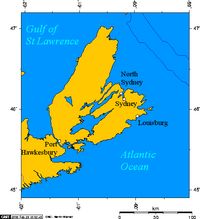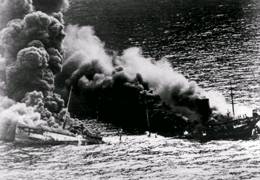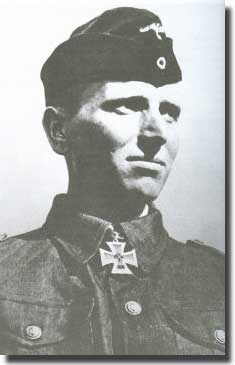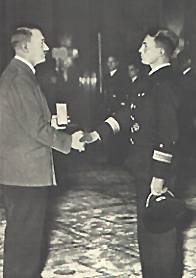|
Wolf Packs slaughter ships in Convoys SC-7 and HX-79, in October 1940
Introduction.
Given the ocean escort was provided by a single sloop, HMS Scarborough for the first ten days, and that no air cover was available, here was a disaster just waiting to happen. On reaching the Western Approaches, the Wolf Pack struck, sinking 20 ships. SC-7 sails. Type of cargoes carried in convoy ships. The largest of the 34 ships was the Admiralty tanker SS Languedor of 9,512 tons, and a load of important trucks filled the holds of SS Empire Brigand. The majority of the ships belonged on the British Register, but others had their home ports in Norway, Greece, Holland, and Sweden. Off Scotland. The Wolf Pack attacks. The next day brought both the sloop HMS Fowey, and a new corvette HMS Bluebell to back up the escort, but there was little they could do to stem the tide of the assault, as three more ships were torpedoed including the valuable tanker Languedoc, all sunk. On the 18th, the escort was again strengthened by the sloop HMS Leith, and the corvette HMS Heartsease, but the U-Boats reigned supreme, sinking another seven ships, the iron ore carrier SS Creekirk sank so quickly, all her crew of 36 going with her.
The Blackest Day of all. SS Empire Brigand and her load of trucks disappeared beneath the waves, 6 of her crew died, the Commodore's ship was not immune, and SS Assyrian sank beneath him, but Vice Admiral Mackinnon was saved. SS Fiscus loaded with steel sank like a stone with but one survivor from her crew of 39. Twenty ships out of 34 in convoy had now been sunk, the tonnage lost, 79,592, and Otto Kretschmer in his U-99 bagged seven of them for himself. He was a remarkable U-Boat skipper, although he operated for only 18 months of WW2 before being captured, he sank 56 ships totalling 313, 611 tons, a feat unequalled by any other U-Boat Captain over the entire period of WW2.
(see "Top Ten German U-Boat Aces of World War 2") U-Boats break off. Once again the U-Boats became a nightmare for all the ships in convoy HX-79. Ships sunk. Loch Lomond steel/lumber for Methil, straggled, sunk by U-100 Oct. 20. Shirak - Kerosene for London, damaged by U-47 Oct. 19, sunk by U-48 Oct. 20, no casualties. Sitala - 8444 tons, crude oil for Manchester, sunk by U-100 Oct. 20, 1 died. Caprella - 11 300 tons, fuel oil for Mersey, sunk by U-100 Oct. 20, 1 died. Whitford Point - 7840 tons, steel for Liverpool, sunk by U-47 Oct. 20, 37 died. Bilderdijk - 8640 tons, grain/general, sunk by U-47 [Uboat.net says U-38] Oct. 19, no casualties. Janus - fuel oil for Clyde, straggled, sunk by U-46 Oct. 20. Ruperra - steel/scrap iron/aircraft for Glasgow, sunk by U-46 Oct. 19, 30 died. Athelmonarch - Molasses for Liverpool, damaged by U-47 Oct. 20. Matheran -3000 tons, iron/1200 tons zinc/general for Liverpool, sunk by U-38 Oct. 19, 9 died. Uganda - 2006 tons, steel/6200 tons lumber for Milford Haven, sunk by U-38? Oct. 19 [Arnold Hague says U-47], no casualties. La Estancia - 8333 tons, sugar for Belfast, sunk by U-47 Oct. 20, 1 died. U-Boat individual successes. U-100, 3 ships sunk. U-46, 2 ships sunk. Both U-38 and U-48 each claimed a single ship. Thus convoy HX-79 lost 13 ships from her total of 49.
Conclusion. Both convoys were unlucky to be attacked by a Wolf Pack that included two of the top Captains in Donitz's U- Boat arm, Gunter Prien and Otto Kretschmer, whose creed was:" One torpedo-one ship." He never wasted one of his precious torpedoes. Between them they accounted for 13 ships, quite an amazing effort.
The U-Boats in but two days had a real picnic, 33 ships sunk, no losses of their own, a wonderful result for Donitz's U-Boat arm. But a sad time for the British convoy system, proving how essential it was for all east and west bound convoys ploughing the North Atlantic run, to have strong escorts to counter the U- Boat pack attack tactics.
Donitz moved his U-Boats around in the North Atlantic in WW2 like they were pieces on a chess board. "Befehlshaber der Unterseeboote (BdU)" was his control centre, and he would signal individual boats eg to home on a convoy, and when sufficient numbers were in place he would order ATTACK. I guess individual subs would report their successes to BdU, and the German Navy would keep immaculate records, they might well have an assessment team at work to throw out frivilous claims. I think post war the British record of ships sunk by name, when, and where was most likely used to check out the U-boat claims. Post WW2 the US Navy had a look at all their Submarine Captain's claims. Some US statistics relating to the Submarine war in the Pacific for WW2. The US Navy and its Submarine arm, over WW2 in the Pacific, claimed to have sunk 4,000 Japanese ships to add up to a gross tonnage of 10 Million tons. Post war, the Joint Army-Navy Assessment Committee ( short title JANAC ) reassessed all these claims that had been credited to the individual Captains and their submarines, and amended them to read:
But those two days when the U-Boats got amongst two convoys was truly amazing. |





